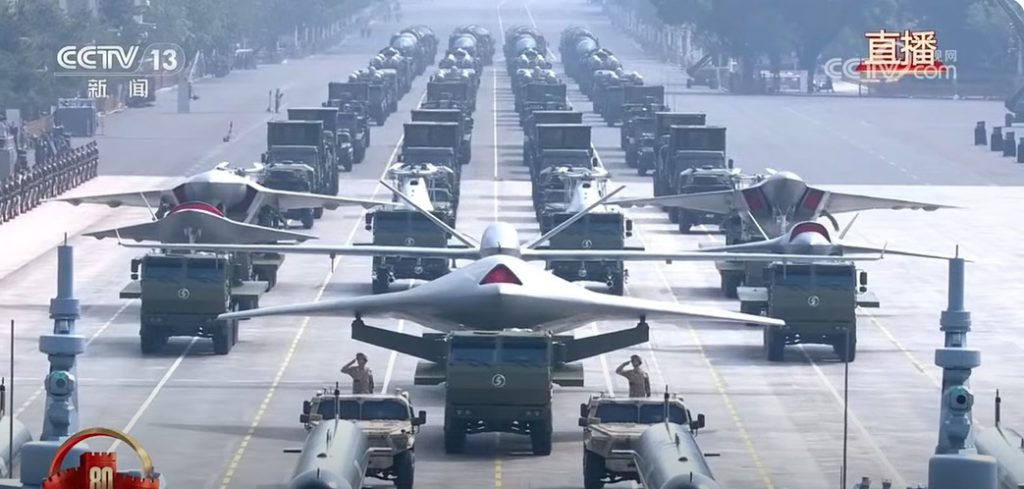Unveiling the Future of Aerial Warfare: China’s 2025 Victory Day Parade Highlights
A Showcase of Unmanned Aerial Vehicles
On September 3, 2025, the 2025 Victory Day parade in Tiananmen Square, Beijing, presented a stunning array of military advancements, with unmanned combat aerial vehicles (UCAVs) taking center stage. This event not only celebrated China’s military prowess but also highlighted the future of warfare, as advanced aerial technologies become integral to modern military strategy.
The Headliners: New UCAVs
Among the various UAVs on display, two types of advanced tailless unmanned fighters captured significant attention. Both designs are optimized for high performance and low observability. One features a lambda wing configuration with caret-style engine intakes, while the other boasts diamond-shaped wings combined with diverterless supersonic intakes. The latter, measuring over 16 meters in length, includes an extended nose and is designed for extended endurance.
Impressively, the longer aircraft was outfitted with an electro-optical tracking system and a conformal antenna located on the forward upper fuselage. While the specific designations and manufacturers of these aircraft remain undisclosed, they were described by parade commentators as “unmanned air dominance fighters.” Military analysts have since dubbed them as Type A and Type B for identification purposes.
Design Insights: Similarities and Innovations
Images from satellite reconnaissance demonstrate that similar fighter-like designs were being developed at Chengdu Aircraft Corporation and Shenyang Aircraft Corporation. These unveilings at the parade suggest that the showcased models may represent the advancement of ongoing military programs aimed at achieving air superiority.
A significant question arises regarding the operational deployment of these advanced UAVs. Will they act as loyal wingmen alongside manned fighters, operate remotely from ground stations, or function with a high degree of autonomy? Such operational capacities could redefine the approach to aerial combat.
The Loyal Wingmen: A New Era of Collaborative Combat
In stark contrast to the “unmanned air dominance fighters” were two additional UCAVs, specifically identified as “loyal wingman” aircraft. These drones reflect aspects of the U.S. military’s initial collaborative combat aircraft (CCA) initiatives, serving as affordable and attritable systems designed for mass combat effectiveness without the need for extensive payloads or top-tier stealth.
Referred to as Types D and E by analysts, these UCAVs exhibit canted tail fins, a single dorsal engine intake, and an engine configuration reminiscent of the Kratos XQ-58 Valkyrie, underscoring a focus on versatility and operational support.
Production Hints and Tactical Use
The presence of serial numbers on the exhibited drones suggests that they might be more than mere mock-ups, hinting at actual aircraft being prepared for deployment within the People’s Liberation Army (PLA) Air Force’s Western Theatre Command. Such anticipation regarding service-ready models only fuels speculation about their anticipated roles and functionalities.
Maritime Reconnaissance: The Shipborne UAVs
Completing the aerial lineup were four shipborne vertical take-off and landing UAVs designed for maritime reconnaissance. Equipped with electro-optical/infrared sensors and surface search radars, these craft are intended for operational deployment aboard PLA Navy ships, mirroring the capabilities of the U.S. Navy’s MQ-8 Fire Scout.
While these UAVs showcased notable surveillance technology, there remains the potential for weapons capabilities in future iterations, expanding their battlefield utility.
Air Power Reinforcement: Next-Gen Aircraft
The Victory Day parade also featured impressive flybys from the Shenyang J-35, identified as China’s next-generation carrier-based fighter, along with the KJ-600 airborne early warning and control aircraft. Both platforms are slated for integration into the air wing of the Type 003 Fujian aircraft carrier, which is slated to deploy advanced catapult and arrestor gear for enhanced aircraft operability.
Roy Choo’s detailed overview not only emphasizes the technological strides made by China in the domain of unmanned warfare but also points toward a rapidly changing landscape in aerial combat, where collaboration between manned and unmanned systems resonates with strategic military objectives. The 2025 Victory Day parade was not just a display of military might; it was a clear signal of the evolving nature of warfare in the modern age.

